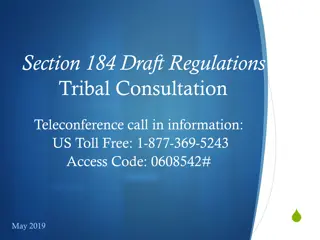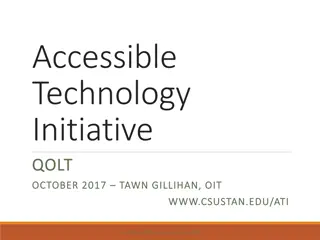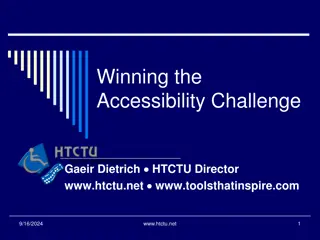Voluntary Consensus Guidelines for State Adult Protective Services Systems
The Administration for Community Living envisions a system that supports older adults and adults with disabilities to live where they choose without abuse or neglect. The lack of federal funding for Adult Protective Services has led to inconsistencies in practices, populations served, and services provided. Developing APS guidelines can ensure consistency, interdisciplinary coordination, and culturally competent service delivery nationwide.
Download Presentation

Please find below an Image/Link to download the presentation.
The content on the website is provided AS IS for your information and personal use only. It may not be sold, licensed, or shared on other websites without obtaining consent from the author. Download presentation by click this link. If you encounter any issues during the download, it is possible that the publisher has removed the file from their server.
E N D
Presentation Transcript
Voluntary Consensus Guidelines for State Adult Protective Services Systems May 2020 1
ACLs Vision The Administration for Community Living (ACL) envisions a comprehensive, multidisciplinary system that effectively supports older adults and adults with disabilities so they can exercise their right to live where they choose, with the people they choose, and fully participate in their communities without threat of abuse, neglect, self-neglect, or financial exploitation. 2
Building Consistency Among APS Programs No federal formula grant funding for APS (like there is for the child welfare system) States and local agencies have developed a wide variety of APS practices, resulting in significant variations For example, APS systems differ in: populations served settings in which services are available types of services provided relationships with other service providers and the justice system timeliness of responses 3
Why Develop APS Guidelines? 4
Building Blocks to a National APS System ACL Office of Elder Justice and Adult Protective Services National Adult Maltreatment Reporting System (NAMRS) APS Technical Resource Center Voluntary Consensus Guidelines for State APS systems (APS TARC) (OEJAPS) 5
Tomorrow Older Americans Act Title VII National Center on Elder Abuse National Data on APS Elder Justice Innovation Grants Recommended Program Standards Office of Elder Justice & APS ACL Leadership in Federal Elder Justice Efforts Recommended Practice Models NAMRS TA for APS programs State APS Grants Seamless Partnership with Aging & Disability Services APS TARC APS Guidelines Evidence-based Interventions Today 6
Purpose of the APS Guidelines Provide a core set of principles and common expectations to encourage consistency among APS programs Help ensure that adults are afforded similar protections and service delivery regardless of where they live in the U.S. Support interdisciplinary and interagency coordination Enhance effective, efficient, and culturally competent delivery The Guidelines do not constitute a standard nor a regulation and will not create any new legal obligations, nor impose any mandates or requirements. They will not create nor confer any rights for, or on, any person. ACL will update the Guidelines at regular intervals. 7
ACLs Approach for the Guidelines ACL served as facilitator for the development of the 2016 Guidelines and for the updates of the Guidelines, including facilitating an extensive and wide-reaching stakeholder engagement and outreach process. ACL applied the Office of Management and Budget (2016) and National Institute of Standards and Technology (2001) process for creating field-developed, consensus-driven guidelines. To eliminate unnecessary duplication and complexity in the development and promulgation of the Guidelines, ACL s process remains consistent with the guidance of the National Institutes of Standards and Technology 15 CFR Part 287 (2020). 8
1. Program Administration 1A. Ethical Foundation of APS Practice 1B. Protecting Program Integrity 1C. Definitions of Maltreatment 1D. Population Served 1E. Mandatory Reporters 1F. Coordination With Other Entities 1G. Program Authority, Cooperation, Confidentiality, and Immunity 1H. Staffing Resources 1I. Access to Expert Resources 1J. Case Review Supervisory Process 1K. Worker Safety and Well-being 1L. Responding During Community Emergencies 1M. Community Outreach and Engagement 1N. Participating in Research Time Frames 2A. Responding to the Report/Initiating the Investigation 2B. Completing the Investigation 2C. Closing the Case Receiving Reports of Maltreatment 3A. Intake 3B. Screening, Triaging, and Assignment of Screened-in Reports Conducting the Investigation 4A. Determining If Maltreatment Has Occurred 4B. Conducting a Psychosocial Assessment 4C. Investigations in Residential Care Facilities 4D. Completion of Investigation and Finding Service Planning and Service Implementation 5A. Voluntary Service Implementation 5B. Involuntary Service Implementation 5C. Closing the Case Training 6A. Case Worker and Supervisor Minimum Educational Requirements 6B. Case Worker Initial and Ongoing Training 6C. Supervisor Initial and Ongoing Training APS Program Performance 7A. Managing Program Data 7B. Evaluating Program Performance What Do the Guidelines Cover? 2. 3. 4. 5. 6. 7. 9
Seven Domains of APS Practice 1. Program Administration 2. Time Frames 3. Receiving Reports of Maltreatment 4. Conducting the Investigation 5. Service Planning and Service Implementation 6. Worker and Supervisor Training 7. Program Performance & Quality Assurance 10
Domain 1: Program Administration Broadest domain, comprising 14 elements (topics) Encompasses elements related to the running of an APS program, but does not include practice-related items which are handled in other domains Key recommendations include encouraging APS to: establish and adopt, and annually review, a code of ethics have adequate staffing to handle caseloads share case information with law enforcement participate in multidisciplinary teams provide resources to ensure worker safety 11
Domain 1: Program Administration Elements 1A. Ethical Foundation of APS Practice 1B. Protecting Program Integrity 1C. Definitions of Maltreatment 1D. Population Served 1E. Mandatory Reporters 1F. Coordination With Other Entities 1G. Program Authority, Cooperation, Confidentiality, and Immunity 1H. Staffing Resources 1I. Access to Expert Resources 1J. Case Review Supervisory Process 1K. Worker Safety and Well-being 1L. Responding During Community Emergencies 1M. Community Outreach and Engagement 1N. Participating in Research 12
Domains that Guide Practice: 25 APS is charged with receiving and responding in a timely manner to reports of maltreatment and working closely with clients and a wide variety of allied professionals to provide services that maximize clients safety and independence. The following domains address these elements of APS practice: Domain 2. Time Frames Domain 3. Receiving Reports of Maltreatment Domain 4. Conducting the Investigation Domain 5. Service Planning and Service Implementation 13
Domain 2. Time Frames Encompasses elements related to the timing (though not the content) of: Case initiation Investigation closure Case closure Key recommendations include: Visits to alleged victims should be face-to-face. Two levels of response are outlined: within 24 hours for emergency cases and within 5 days for less imminent cases. No recommendations are offered as to time frames for completing the investigation or closing the case. However, guidance is provided as to what should be considered for creating policy about time frames. 14
Domain 3. Receiving Reports of Maltreatment Encompasses elements related to how reports of alleged adult maltreatment should be received and what information should be collected and how it should be used to initiate the investigation: Intake Screening, prioritizing, and assignment of screened-in reports Key recommendations include: Intake should be open 24/7 and fully accessible. Intake workers should be APS workers. Screening, triaging, and case assignment protocols should be standardized across the APS program. 15
Domain 4. Conducting the Investigation Encompasses elements related to determining if maltreatment has occurred: Conducting a psychosocial assessment Investigations in residential care settings Completing the investigation and determining the finding Key recommendations include: All types of maltreatment should be noted and investigated. The investigation may continue, but the client has the right not to participate in it. Use of multidisciplinary teams is encouraged. Standardized screening tools for decision-making capacity and maltreatment are encouraged. Acceptance of APS services is voluntary (except in certain cases). Workers should have received training to investigate circumstances described in report (e.g., reports in residential facilities). 16
Domain 5. Service Planning and Service Implementation Encompasses elements related to assessing the need for and delivering services to clients: Voluntary service implementation Involuntary service implementation Closing the case Key recommendations include: Intervene as early as possible. Target services to the kinds of abuse experienced. Consider longer-term interventions (building alliances). Prioritize services that break down isolation. Services should be monitored until a case is closed. Success is defined by the client. 17
Domain 6: Training Encompasses elements related to hiring, onboarding, maintaining, and supporting the APS workforce. Case Worker and Supervisor Minimum Educational Requirements Case Worker Initial and Ongoing Training Supervisor Initial and Ongoing Training Key recommendations include: Workers should have at least a BA/BS degree, and preference should be given to those with a Master s degree. Training has four components: orientation, supervised fieldwork, core competencies, and advanced or specialized training. Supervisors should be trained in supervisory skills within the first year of acting as a supervisor. 18
Domain 7: Program Performance Encompasses elements related to collection and management of program data and evaluation of program performance: Managing Program Data Evaluating Program Performance Key recommendations include: Data should be congruent with NAMRS and should be kept long enough to ensure their availability for quality assurance efforts. Programs should compile a written report on the program s performance; performance measures should include timeliness as well as client-centered outcomes. 19
The Process for Updating the APS Guidelines 20
Process of Updating the Guidelines Phase I Reviewed new research Updated literature review (2014 2018) Drafted proposed updates based on new research Phase II Engaged the field and the public Engaged stakeholders through 5 webinars and Request for Information Analyzed stakeholder feedback and created report Prepared feedback for review by a technical expert panel (TEP) Phase III Consulted the experts Held five TEP virtual working meetings Updated Guidelines based on TEP decisions 21
Literature Search: Methods and Results Updated literature search: April 2014 November 2018 Searched 13 databases Results/Implications: 24 peer-reviewed journal articles Research relevant to 6 out of 7 Guidelines domains (nothing relevant to Domain 3: Receiving Reports of Maltreatment) Several studies had findings that impacted several domains Actions taken: Added text to background only (but did not change guidance); or added text to background and changed guidance None of the original guidance was deleted 23
Studies focused on: 1. Service variables coordination with other professions, use of MDTs/Forensic Centers 2. APS procedures using a decisional support system, adding mental health screening, using goal-attainment scaling 3. Client outcomes mistreatment status at case closure, rate of return to APS system, client satisfaction 4. Investigation outcomes rates of service refusal, rates of substantiation, rates of prosecution 5. Training outcomes measuring knowledge, competence 6. APS worker outcomes job satisfaction, secondary trauma levels, hazard exposure 24
Phase II: Engaged the Field and the Public 25
Public Comment Period ACL Request for Information Web page and email March May 2019 26
Stakeholder Webinars Hosted 5 webinars: Approximately 190 stakeholders, representing 39 states and D.C., and representing 10 fields (the majority from APS) participated. How familiar are you with the APS Guidelines? Familiarity Percentage Extremely familiar 3% Very familiar 32% Somewhat familiar 30% Slightly familiar 24% Not at all familiar 10% 27
Number of Comments 278 comments were coded for relevant feedback: 216 comments related specifically to the content of the Guidelines (e.g., background and guidance). 62 comments concerned other topics related to the Guidelines (e.g., formatting, frequency of updating dissemination). 28
Nature of the Comments Revise wording 40 Remove content 3 Referencing other sources/programs 7 New section 1 New practice to consider 2 Definition 7 Clarification 8 Additional content 51 0 10 20 30 40 50 60 30
Phase III: Consulted the Experts 31
Role of the Technical Expert Panel Review new research and its applicability to the APS Guidelines Review stakeholder comments and determine applicability to the APS Guidelines Identify items not revealed in research or public comments Apply real world experience and wisdom: the voice of the field 32
Key Decisions by the TEP Agreed with stakeholder recommendations Implemented recommendation: 29 Implemented with additional revisions or with alternative approach: 17 Did not agree with stakeholder recommendations: 19 TEP-initiated revisions/additions: 16 33
Final Updated Guidelines https://acl.gov/programs/elder-justice/final-voluntary-consensus- guidelines-state-aps-systems 34
Whats Next? ACL will update the Guidelines with new findings and stakeholder input at regular intervals. The Guidelines are currently being used by ACL to inform technical assistance to a sample of pilot state APS administrators. As part of the pilot, states are identifying practice or policy changes they would like to make to better align with the Guidelines. Alignment with the Guidelines as a measure of a good program? 35
Questions? 36
Thank you! Thank you! 37
References AARP Public Policy Institute. (2011). Adult protective services: Increased demand and decreased funds [Fact sheet]. Retrieved from https://assets.aarp.org/rgcenter/ppi/ltc/fs212-ltc.pdf Aurelien, G., Beatrice, M., Cannizzo, J., Capehart, A., Gassoumis, Z., & Greene, M. (2018a). FFY NAMRS 2017 Report 1: Agency Component. Submitted to the Administration of Community Living, U.S. Department of Health and Human Services. Aurelien, G., Beatrice, M., Cannizzo, J., Capehart, A., Gassoumis, Z., & Greene, M. (2018b). NAMRS FFY 2017 Report 2: Key Indicators. Submitted to the Administration of Community Living, U.S. Department of Health and Human Services. Beach, S. R., Liu, P.-J., DeLiema, M., Iris, M., Howe, M. J. K., & Conrad, K. J. (2017). Development of short-form measures to assess four types of elder mistreatment: Findings from an evidence-based study of APS elder abuse substantiation decisions. Journal of Elder Abuse & Neglect, 29(4), 229 253. Booker, J. G., Breaux, M., Abada, S., Xia, R., & Burnett, J. (2018). Assessment of older adults' satisfaction with adult protective services investigation and assistance. Journal of Elder Abuse & Neglect, 30(1), 64 74. Burnes, D., Connolly, M. T., Hamilton, R., Lachs, M. S. (2018). The feasibility of goal attainment scaling to measure case resolution in elder abuse and neglect adult protective services intervention. Journal of Elder Abuse & Neglect, 30(3), 209 222. Burnes, D. P. R, Rizzo, V. M., & Courtney, E. (2014). Elder abuse and neglect risk alleviation in protective services. Journal of Interpersonal Violence, 29(11), 2091 2113. Connell-Carrick, K., & Scannapieco, M. (2008). Adult protective services: State of the workforce and worker development. Gerontology & Geriatrics Education, 29(2), 189 206. Conrad, K. J., Iris, M., & Liu, P.-J. (2017). Elder abuse decision support system: Field test outcomes, abuse measure validation, and lessons learned. Journal of Elder Abuse & Neglect, 29(2 3), 134 156. Daly, J. M., Jogerst, G. J., Haigh, K. M., Leeney, J. L., & Dawson, J. D. (2005). APS workers job requirements associated with elder abuse rates. Social Work in Health Care, 40(3), 89- 02. Du Mont, J., Kosa, D., Yang, R., Solomon, S., & Macdonald, S. (2017). Determining the effectiveness of an elder abuse nurse examiner curriculum: A pilot study. Nurse Education Today, 55, 71 76. 39
References, contd Ghesquiere A., Plichta, S. B., McAfee, C., & Rogers, G. (2018). Professional quality of life of adult protective service workers. Journal of Elder Abuse & Neglect, 30(1), 1 19. Jogerst, G. J. J., Daly, J. M., Dawson, J. D., Brinig, M. F., Schmuch, G. A., & Peek-Asa, C. (2004). APS investigative systems associated with county reported domestic elder abuse. Journal of Elder Abuse & Neglect, 16(3), 1 17. Mosqueda, L., Wiglesworth, A., Moore A. A., Nguyen, A., Gironda, M., Gibbs, L. (2016). Variability in findings from adult protective services investigations of elder abuse in California. Journal of Evidence-Informed Social Work, 13(1), 34 44. National Adult Protective Services Association & National Association of State Units on Aging. (2012). Adult protective services in 2012: Increasingly vulnerable. Retrieved from http://www.napsa-now.org/wp- content/uploads/2012/06/BaselineSurveyFinal.pdf Pickering, C. E. Z., Ridenour, K., Salaysay, Z., Reyes-Gastelum, D., & Pierce, S. J. (2018). EATI Island: A virtual reality- based elder abuse and neglect educational intervention. Gerontology & Geriatrics Education, 39(4), 445 463. Ramsey-Klawsnik, H. (2015). Investigation protocols [National Adult Protective Services Resource Center technical assistance brief]. Retrieved from http://www.napsa-now.org/wp-content/uploads/2015/03/TA-Brief-Invesitgation- Protocols.pdf Ramsey-Klawsnick, H., & Teaster, P. (2012). Sexual abuse happens in healthcare facilities: What can be done to prevent it? Generations, 36(3), 53 59. Storey, J. E., & Prashad, A. A. (2018). Recognizing, reporting, and responding to abuse, neglect, and self-neglect of vulnerable adults: An evaluation of the re:act adult protection worker basic curriculum. Journal of Elder Abuse & Neglect, 30(1), 42 63. Susman, A., Lees, K. E., & Fulmer, T. (2015). Understanding repeated visits to adult protective services. The Journal of Adult Protection, 17(6), 391 399. Teaster, P. B., Dugar, T., Mendiondo, M., Abner, E. L. , Cecil, K. A., & Otto, J. M. (2006). The 2004 survey of adult protective services: Abuse of vulnerable adults 18 years of age and older. Washington, DC: National Center on Elder Abuse. 40























